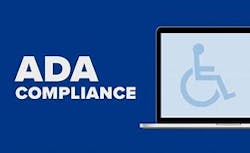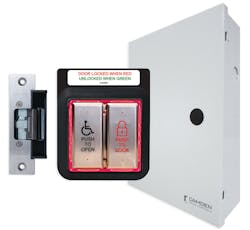Tips on Automatic Door Controls and Restroom Code Compliance Applications
This article originally appeared in Access Control Trends & Technology 2023, a special bonus publication to Security Business magazine, Security Technology Executive, and Locksmith Ledger magazine.
Applications for access control are wide and varied. Countess enterprises across all industry sectors have adapted varying access control technologies and capabilities to meet their site-specific needs and requirements. Together with their systems integrations partners, stakeholders can determine the access measures that are best tailored to their individual facilities.
However, when it comes to automatic door control and code compliance in restroom applications, the requirements are typically spelled out very clearly and in no uncertain terms. The Ontario Building Code (OBC), which went into effect on January 1, 2015, for example, mandated the installation of emergency call systems in barrier-free and universal washrooms. Although the code requirements were originally only applicable to the province of Ontario, Canada, they continue to serve as a model for emerging code requirements for emergency call systems in universal washrooms across North America.
Codes & Standard – What You Need to Know
Barrier-free access to buildings and restroom facilities is mandated across North America by state or provincial building codes. In the U.S., barrier-free access is also mandated by federal law but allows interpretation and enforcement to be determined by each individual state.In Canada on the other hand, the National Building Code provides a model building code that is used where no provincial code is adopted and also forms the basis for all provincial building codes. The result of these vastly different approaches is that the Canadian requirements for automatic doors on restrooms are uniform whereas the American requirements can vary markedly from state to state. Both end users and systems integrators should refer to the specific building codes that apply in their particular state.
There is one common objective, however, and that is to provide high visibility and enhanced user convenience in ADA-compliant automatic door applications. Therefore, having a solid understanding of The Americans with Disabilities Act (ADA) is so important.
The Americans with Disabilities Act (ADA)
A federal law, ADA, is designed to provide equal access for all citizens. All buildings that are open to the public are required to provide equal access for people with disabilities. All visitors and occupants must be able to safely enter and exit the building and move throughout the building without obstruction. There are two key technical regulations that inform the Americans with Disability Act. These are the ADA Accessibility Guidelines (ADAAG) and the Uniform Federal Accessibility Standard (UFAS). Both the ADAAG and UFAS are based in large part on the technical criteria that is specified in the national voluntary consensus standard, ANSI A117.1
Understanding ANSI Standards
The American National Standard Institute (ANSI) is a private, nonprofit membership organization that provides a voluntary system for the development of standards, including those applicable to the installation of automatic doors.
There are two ANSI standards that are commonly cited by both U.S. and Canadian building codes in regard to automatic doors in restrooms: ANSI A117.1 is the standard for Buildings and Facilities - Providing Accessibility and Usability for Physically Disabled People, and ANSI A156.19, which is the standard for Power Assist and Low Energy Power Operated Doors.
Building Codes
Because each U.S. state has the authority to interpret federal ADA requirements and to legislate those requirements as law as they see fit, many states have different approaches to accessibility regulations. Some states have adopted ANSI A117.1, the UFAS, ADAAG or model building codes (such as the International Building Code or Universal Building Code), all of which are relatively similar. Another group of states relies on one or another of those sources as a basis for their regulations but have other requirements and do not reference them by name.
A third and smaller group of states have legislated their own unique standard and code requirements. In addition to these building codes, there are others that your restroom project may need to comply with. The NFPA National Fire Code or International Fire Code is of particular importance, and because restroom doors are egress doors, compliance will be required by the local AHJ.
Types of Systems
Restroom control privacy systems are comprised of various system components and are designed to keep in compliance with applicable codes and requirements. They represent a growing segment of the access control market as the industry is experiencing rapid growth in the installation of automatic operators on restroom doors, as well as in a wider scope of building occupancies. Restroom control kits should provide a complete solution that includes ‘Push/Wave to Open’ and ‘Push/Wave to Lock’ activation switches, a 2 Amp. power supply and controller in a small metal cabinet, ‘universal’ electric strike, and door contacts.
New capabilities of traditional devices, and the introduction of completely new types of system components, are markedly improving restroom access for people with disabilities. Although the control of automatic doors in restrooms has traditionally employed much all of the same components as those used in entrance/egress applications, current restroom control systems leverage a range of components that have been designed to serve these specific requirements.
A system includes 4 basic components:
- An electrified lock - this can be a strike, magnetic lock, or electrified cylindrical or mortise lockset
- An activation device to energize the electrified lock - this can be a push button, push plate switch, or presence detector, such as a PIR or ultrasonic detector
- A visual ‘occupied’ or ‘vacant’ indicator – which can be a LED annunciator outside the locker room to let building occupants know that the room is unavailable.
- A visual ‘locked’ indicator -- This indicator is placed inside the room to let occupants know that the door is locked.
Secured or Unsecured Locks Systems
- Unsecured (unlocked) rooms entered by a manual lockset or electronic activation device -- By far, the most common
- Secured (locked) rooms entered by using a keypad, card reader or remote activation device (wired or wireless). Often used to control vagrancy and other unauthorized use of the room
Wireless Systems
Sometimes it can be difficult to run wired systems. Advances in wireless technologies have enabled the introduction of normally unlocked, restroom control systems with battery-powered wireless activation switches. ‘Occupied’ / ’vacant’ annunciation outside the restroom, and ‘locked’/ ’unlocked’ annunciation inside the restroom can be provided by door jamb mounted narrow 1/2” LED annunciators, making wireless installations possible and compliant.
Applications and Opportunities
There’s a wide range of applications for restroom control privacy systems. These include shared restrooms (2 doors accessing a common restroom), nursing stations, and ADA-compliant ‘Universal’ restrooms (barrier-free systems with automatic door operators) that are common in healthcare facilities mandated by building codes in commercial buildings. Other configurations for remote door locking include interrogation rooms, dressing rooms and meeting rooms.
As building codes and requirements continue to evolve, it’s critically important for facility teams and systems integrators to stay abreast of the latest solutions to ensure that restroom control/privacy systems are delivering what’s needed for users as well as for compliance.

